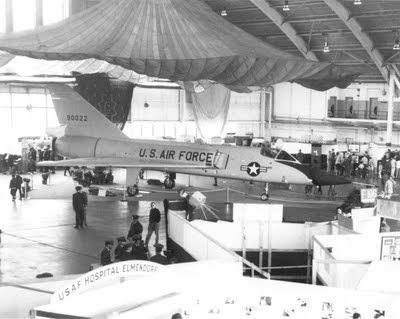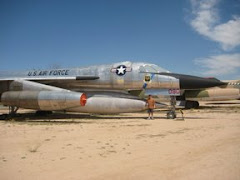
(Photo of #59-022, from Marty Isham Collection via http://www.f-106deltadart.com [I shamelessly heisted it, but you should definitely stop by this site, since they are the penultimate experts on all things F-106!])
In the late 1960s, the F-106 fleet had been selected to be modified with Supersonic external fuel tanks and in-flight refueling equipment. This was begun in 1967. The first of the sixes to obtain these modifications were Washington State based sixes. On October 3, 1967, F-106A, #59-022 was scheduled for a functional test flight after having these modifications.
The F-106 was a wonderful craft. It could dog-fight. It could go supersonic and reach incredible altitudes. It was equipped with the amazing MA-1 fire control system, which, hooked into the SAGE network could guide it to a target and fire its weapons almost completely automatically. In its almost 40 years, it had the best safety record of all Air Force single engine aircraft, still, of the 340 aircraft built, 112 were lost in operational accidents, either on the ground or in the air.
Major Richard S. Petersen was assigned. He filed a DD form 175 (IFR flight plan, or Instrument Flight Rules[indicates he would be using instruments and electronic means to fly the aircraft, usually used in poor weather, rather than visual flight rules used in clear air]) at the Base Operations as LK 19 (Lima Kilo 19). The estimated departure time was 1700Z, or 1000 local, for an hour and 15 minute test hop. He began his weather briefing at about a quarter to 0845 (1545z). The weather at McChord was 1000 feet scattered, 4500 scattered, and 7000 broken, with 15 miles visibility. Forecast was 800 broken, 4000 broken, and 7000 overcast with visibilty at 7 miles with light rain. He got a weather waiver from the deputy commander for flight operations (This indicates that it probably wasn't a big deal to fly in weather, since the waiver was given). Clearance was filed at 1556Z (0856 PST), a little over an hour ahead of scheduled departure.
Petersen went to the Fighter Squadron, donned his flight gear and proceeded to the flight line. He did his walk around and began his preflight. After engine start, though, he told the crew chief that the attitude director indicator (ADI) would not erect properly. An instrument technician was sent to the aircraft. He replaced the ADI power supply. Satisfied with the aircraft, the pilot taxied out and began his check lists, now 46 minutes behind schedule (1046).
Lima Kilo 19 was cleared to flight level 360, or 36,000 feet. departure instructions were to turn right to a heading of 288 and maintain 4000 feet until he was 7 miles west. When he reached this point he was cleared by RAPCON to climb to his assigned altitude. He was handed of to Seattle Center and then to ADC Control (landferry) when he was appoximatel;y 20 nautical miles south of Neah Bay for flight monitoring. Landferry cleared LK 19 for his supersonic run on a heading of 150, parallel to the shore, but at 20 miles out.
Lima Kilo 19 requested a 75 mile extension to his supersonic leg. When asked, he reported that his speed was mach 1.3 at 40,000 feet. At 1116 local, Lima Kilo 19 reported that he could not obtain mach and requested a recovery vector. The vector given was 040. He was cleared to descend to FL310 when he requested it. Seattle Center assumed control at 1122 and cleared LK19 to descend to 5000 feet.
At 1122:11 Petersen acknowledged the descent and reported out of 31000. Seven seconds later he told Seattle Center that he, "Would like a minimum of turns on the letdown 'til I can go VFR. I've lost my flight instruments, ..uh..attitude indicator tape." (most F-106s were equipped with vertical tape instruments that were supposed to be easier to read than traditional circular types. Supposed;y they could give more information faster than the traditional type) Two minutes later Petersen advised Seattle Center that he had, "lost all flight instruments of...sh...in a descent at this time--and I'd sorta like to bail out of this thing." The time was 1124:55. This was the last transmission that Lima Kilo 19 made.
Radar plots indicated that he was making a right turn from an Easterly heading to a Westerly heading. The aircraft crashed in an open field in a very steep attitude, the accident report estimated it at 60 degrees nose down. The final heading, on impact was turning right at 061 degrees, putting it on a South West track at that time. Major Petersen did eject, but unsuccessfully. The Canopy, the seat, and his body was discovered about 1/3 of a mile to the Southwest on a hill about 300 feet about the aircraft. The aircraft hit near Raymond Washington.
The weather was mostly cloudy if one reads the forecast correctly. Given the fact that he was cleared for Instrument Flight Rules, and his wish to obtain Visual Flight Rules conditions, it seems likely that his instruments were either giving him faulty or no reading at all. In that sort of environment, there is no horizon to gage attitude by. The motion of the aircraft is enough to over-ride the human cochlea and it is easy to think you are going in the right direction when you are not. Major Petersen seemed completely aware of this and was quite ready to depart the aircraft when his instruments began to go south.
Early F-106 ejection seats were notorious for poor performance. The early seats had been replaced by the "B" seat and finally by the "Zero-Zero" seat. This meant that it could safely take its occupant away from the airframe at Zero Altitude and Zero Speed. By 1967 most of the kinks had been worked out and the "Zero-Zero" seat had been fitted to the entire fleet.
It would appear that bad luck had been a large factor in Major Petersen's demise. First, bad luck that his instruments failed TWICE. Then that he was unable to complete his entire mach run. And, when his instruments failed a second time, his aircraft was in "the soup" (or bad weather) and he could not visually determine the attitude of his aircraft to bring it in safely. Finally, when he DID eject, something (and this accident report fails to identify what) caused him to sustain injuries that killed him.
The Convair F-106 Delta Dart was the interceptor that kept American skies clear of Communist aggressors for almost 40 years. It served with distinction, but never fired a shot in anger. After it was retired the majority of the survivors suffered the semi-inglorious fate of being used as targets. Some defend this as the most noble end for a FIGHTER, they consider it a better fate than sitting on a pole. Others may be saddened that a jet that kept America safe for so long suffered such an indignity. Either way, the SIX was a fighter no matter which side you land on. There are enough that remain today on display that most people will be able to see one in person if they don't mind a short drive.
Sources:
Accident report for #59-022 obtained from USAF.
F-106 Delta Dart.com http://www.f-106deltadart.com/history.htm







No comments:
Post a Comment